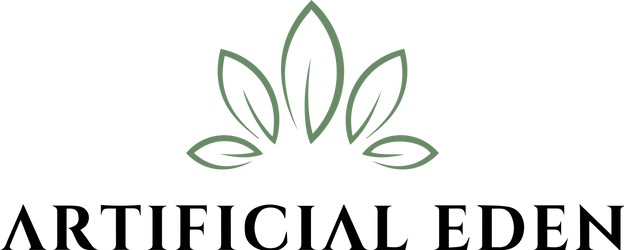
How to Pot Your Artificial Plants & Trees Step-by-Step
How to Pot Your Artificial Plants & Trees Step-by-Step
Imagine this: you’ve just spotted a beautiful plant online and you want to replicate it in your home. But you lack the time, green thumb, or desire required to keep the plant alive. What can you do? You can pot an artificial version of your chosen plant!
Plant maintenance can take a lot of effort, but this doesn’t mean you can’t give your living room a tropical, boho, or classy feel with some foliage! Plants can breathe much-needed life into an otherwise dull room, giving a fresh feel to a room that desperately needs it. Many of us love the look of plants but simply don’t have the time to keep these needy plants alive.
If this sounds like you, you’re in the right place. As artificial plant experts, we’re going to show you exactly how to pot your artificial plants and trees, and answer the most frequently asked questions around potting artificial plants.
How to Pot an Artificial Plant
Step 1: Assess Your Artificial Plant
Artificial plants typically come in a plain starter pot, designed to weigh it down and give it a base, as stems, on a spike, or pre-potted in a container. You’ll be able to tell at a glance what you have. If your plant is pre-potted, and you plan to re-pot, double-check that it’s possible to do so. It will be in 99% of cases, but it will depend on where you got the artificial plant.
Since you’re here reading this article, we can reasonably guess that you’re ready to re-pot it into something more stylish than the weighted base it has come in. You may have already chosen the new pot or planter for your artificial plant, and if so, move on to Step 3 but if you’re not sure yet what kind of planter will work best, move on to Step 2.
Step 2: Choose the Right Pot or Planter

If you’re using your artificial plant to add a pop of vibrancy to your home, it’s best to choose a new pot that complements your interior design. You might want to opt for something that matches one of the tones in each room’s colour scheme, or you might prefer a pot that creates contrast.
A plain, modern-style pot will work just about anywhere with any plant, but don’t forget to consider metallic pots, plant stands, hanging planters, baskets, and unusual planters, depending on the size and style of your plant.
Trailing plants should be elevated to get the most from their foliage, dark plants work best with lighter pots, and baskets work particularly well on the floor. Stick with neutrals to be safe, but don’t be afraid to use the room’s accent colours or choose an artistic pot to be the focal point of the room.
Once you’ve decided what colour pot you’d like, make sure you know what size you are looking for. Fluff the artificial plant, if necessary, and consider the width of the plant. In general, your plant pot should be at least 1/3 of the width of the widest plant of the plant to look right. This isn’t a hard-and-fast rule, but it’s a good one to use if you’re not sure what width you need. Since we aren’t worried about roots, this rule will help you create visual balance.
Remember that one of the many great things about artificial plants is that they don’t need watering. Not only does this mean you can go on holiday without coming home to a bunch of wilted peace lilies, but it also means you don’t need to worry about getting a pot with drainage. This opens up your choices significantly, and means you can focus on making your plant look gorgeous!
Step 3: Gather Your Potting Materials
When you’ve decided on the perfect pot for your faux plant friend, you’ll need to get your hands on some potting materials. You’ve got a few options here depending on how much additional weight you need to keep the plant upright, whether you want to pot it straight into a basket with no other pot, and any other factors like little ones that may get their hands in the pots! You can choose from:
- Earth – looks extremely natural, weighs a lot, cheap to buy (choose potting soil so you don’t get something with lots of clumps or mulch in it, even though your plant doesn’t need the nutrition!)
- Sand – weighs a lot, can look pretty, but perhaps not ideal if you have cats who may use it as a bathroom or kids who will think they can play with it
- Pebbles or slate – looks pretty, weighty, inexpensive for the volume you need (make sure you rinse your pebbles before you use them for the best colour and least dust)
- Glass pebbles – this is a practical option for small planters, you can often find them in garden centres and in the flower arranging area of craft stores.
- Bark – cheap, looks natural, will break down over time, may not be ideal for those with young children if they’re likely to play with it
- Flower arranging foam or polystyrene (though not ideal as it will get everywhere and isn’t very eco-friendly)
You don’t need to overthink this step – just choose something that will work for you. You can always top your choice with artificial moss or a little potting soil for a natural look.
Step 4: Prepare Your Plant & Pot
If necessary, fluff your plant, take off any packaging, and arrange stems. For the next steps, you want to have a really good idea of what your plant will look like once it’s in the right position.
Put your planter in the place you plan to have it and place your plant inside it. Assess whether it looks good standing in the base of the pot, or whether it needs to be raised a little to look best. If so, you’ll need to pre-fill your pot, so do that now if necessary.
Step 5: Hold Your Plant in Position and Fill the Pot
Next, position your artificial plant upright in the middle of the pot. Don’t worry about removing the starter pot, but simply bury it under the sand or earth and fill around it. If you can, have a friend or family member hold the plant upright for you. If you’re filling the pot alone, just take it slow and be sure to take a step back every so often to check it’s upright and correct if it’s leaning to one side.
Once it’s full, cover the plant up to the stem and style as you please, whether that be leaving it as sand or soil, or using a layer of artificial moss or decorative stones.
If your plant is on a spike or you’re arranging single stems, fill your plant pot ¾ of the way full, or more, and push the plant into the material. Then simply cover the top up to the stems with your preferred material.
Top Tips for Repotting Artificial Plants
- If the plant needs to be moved often, use polystyrene or flower arranging foam at the base of the pot to reduce the weight. Besides needing to be heavy enough or supportive enough to keep your plant and pot upright, there’s no need to make it extremely heavy! Cover the top with something large and light, like bark, for a light, attractive covering.
- If your leaves or stems have been bent in transit or storage, you can usually restore them. If you have your silk plants or trees delivered to your door, some of the leaves may be bent to fit into the box. You can restore these leaves by steaming them – simply place your plants in your bathroom and turn your shower to the highest temperature until the unwanted creases in the leaves disappear. If you don’t want to get too much water involved, you can also use a clothes steamer. Just make sure you don’t hold the steamer too close to the leaves! You don’t want to scorch or fade them.
- To make your artificial plants look more natural, start bending the main stem, working towards the end of each branch to create a subtle downward curve. Stagger the tips of the branches around your artificial plant's base for a naturally full look.
Artificial plants are so easy to keep. They work out cheaper in the long run as they don’t require any watering, they won’t overgrow and become too big for their pot, and won’t die on you! They won’t trigger any nasty allergies, and there’s no need to ask the neighbours to come in to water while you go on a well-deserved holiday! Faux plants are ideal for those who love a splash of vibrant colour without all the hassle of maintaining a living-breathing (pretty high-maintenance!) organism.
So, whether you’ve been dreaming of a zany-looking Chinese money plant for the bedroom, a faux monstera for the office, or an artificial lemon tree for the dining room, the pot is often as important as what’s inside. So why not check out some of our fabulous range today?

Leave a comment